Reducing Diagnostic Errors in Saudi Arabian Healthcare Systems
VerifiedAdded on 2021/05/27
|15
|4186
|78
Report
AI Summary
This report addresses the critical issue of diagnostic errors within Saudi Arabian hospitals, emphasizing their impact on patient safety and healthcare quality. The study highlights various types of diagnostic errors, including missed, wrong, and delayed diagnoses, and their potential consequences, referencing a Harvard medical practice study that found 17% of patient deaths were due to diagnostic errors. The core of the report is a quality improvement plan designed to reduce these errors, particularly those stemming from inaccurate or untimely laboratory results. The plan focuses on implementing Laboratory Information Systems (LIS) to automate lab procedures, increase diagnostic result accuracy, and improve communication. The report details the plan's aims, mechanisms, and measures, including data collection through questionnaires from LIS users within the King Abdul-Aziz Medical City Hospital. Ethical considerations are also addressed, along with the limitations of the study. The expected outcome is an improvement in patient safety and an increase in the reliability of the healthcare system in Saudi Arabia.
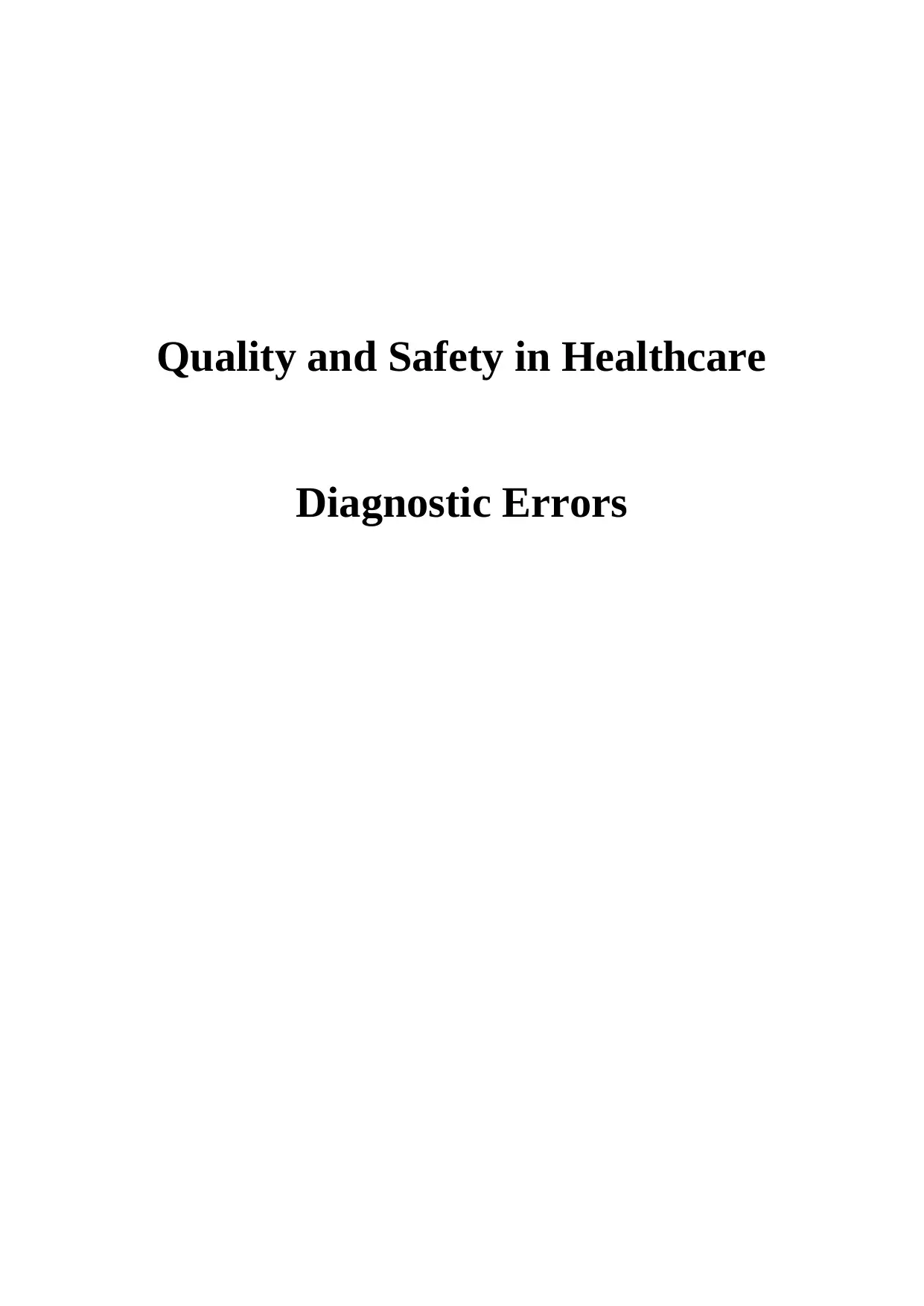
Quality and Safety in Healthcare
Diagnostic Errors
Diagnostic Errors
Paraphrase This Document
Need a fresh take? Get an instant paraphrase of this document with our AI Paraphraser
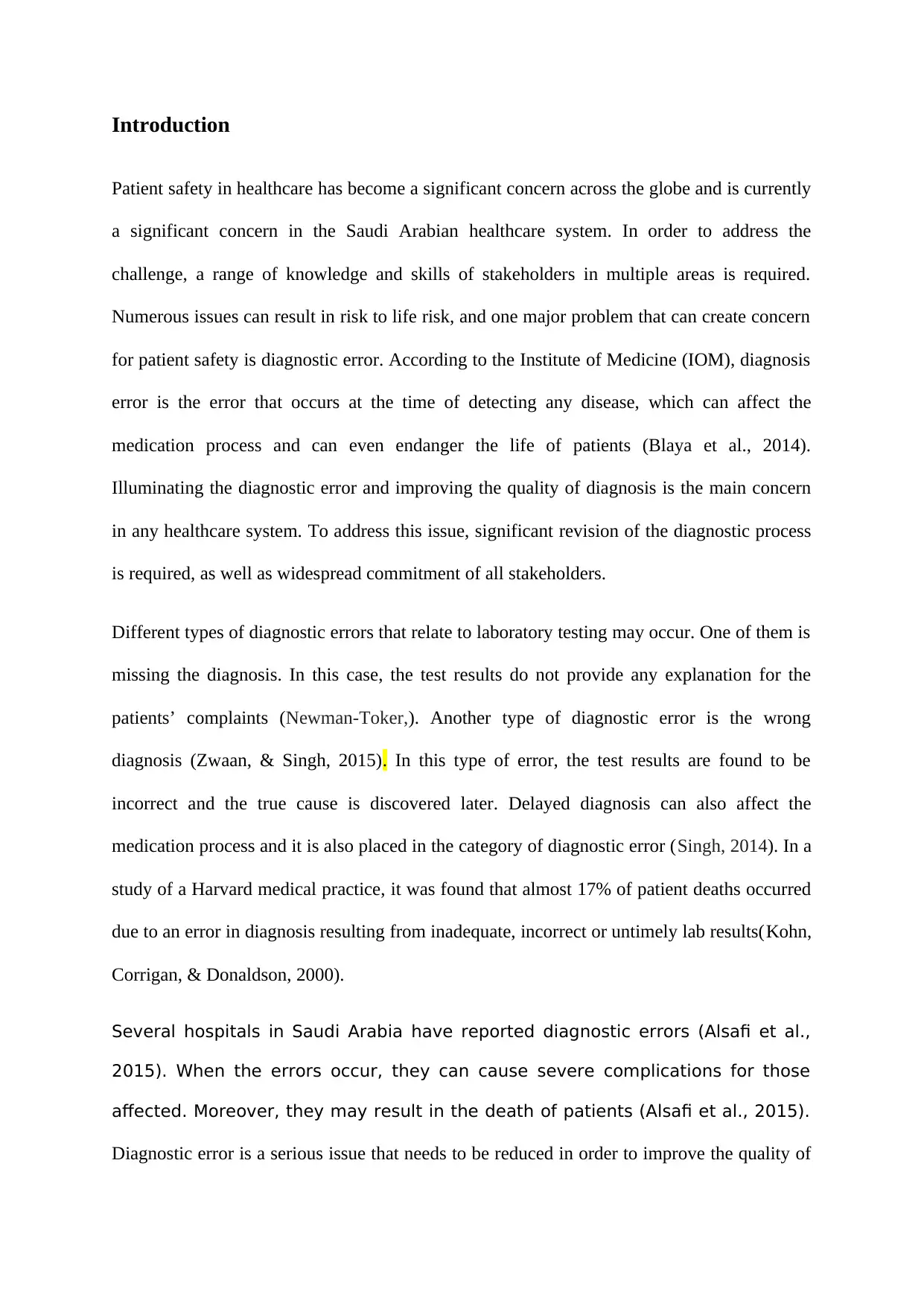
Introduction
Patient safety in healthcare has become a significant concern across the globe and is currently
a significant concern in the Saudi Arabian healthcare system. In order to address the
challenge, a range of knowledge and skills of stakeholders in multiple areas is required.
Numerous issues can result in risk to life risk, and one major problem that can create concern
for patient safety is diagnostic error. According to the Institute of Medicine (IOM), diagnosis
error is the error that occurs at the time of detecting any disease, which can affect the
medication process and can even endanger the life of patients (Blaya et al., 2014).
Illuminating the diagnostic error and improving the quality of diagnosis is the main concern
in any healthcare system. To address this issue, significant revision of the diagnostic process
is required, as well as widespread commitment of all stakeholders.
Different types of diagnostic errors that relate to laboratory testing may occur. One of them is
missing the diagnosis. In this case, the test results do not provide any explanation for the
patients’ complaints (Newman-Toker,). Another type of diagnostic error is the wrong
diagnosis (Zwaan, & Singh, 2015). In this type of error, the test results are found to be
incorrect and the true cause is discovered later. Delayed diagnosis can also affect the
medication process and it is also placed in the category of diagnostic error (Singh, 2014). In a
study of a Harvard medical practice, it was found that almost 17% of patient deaths occurred
due to an error in diagnosis resulting from inadequate, incorrect or untimely lab results(Kohn,
Corrigan, & Donaldson, 2000).
Several hospitals in Saudi Arabia have reported diagnostic errors (Alsafi et al.,
2015). When the errors occur, they can cause severe complications for those
affected. Moreover, they may result in the death of patients (Alsafi et al., 2015).
Diagnostic error is a serious issue that needs to be reduced in order to improve the quality of
Patient safety in healthcare has become a significant concern across the globe and is currently
a significant concern in the Saudi Arabian healthcare system. In order to address the
challenge, a range of knowledge and skills of stakeholders in multiple areas is required.
Numerous issues can result in risk to life risk, and one major problem that can create concern
for patient safety is diagnostic error. According to the Institute of Medicine (IOM), diagnosis
error is the error that occurs at the time of detecting any disease, which can affect the
medication process and can even endanger the life of patients (Blaya et al., 2014).
Illuminating the diagnostic error and improving the quality of diagnosis is the main concern
in any healthcare system. To address this issue, significant revision of the diagnostic process
is required, as well as widespread commitment of all stakeholders.
Different types of diagnostic errors that relate to laboratory testing may occur. One of them is
missing the diagnosis. In this case, the test results do not provide any explanation for the
patients’ complaints (Newman-Toker,). Another type of diagnostic error is the wrong
diagnosis (Zwaan, & Singh, 2015). In this type of error, the test results are found to be
incorrect and the true cause is discovered later. Delayed diagnosis can also affect the
medication process and it is also placed in the category of diagnostic error (Singh, 2014). In a
study of a Harvard medical practice, it was found that almost 17% of patient deaths occurred
due to an error in diagnosis resulting from inadequate, incorrect or untimely lab results(Kohn,
Corrigan, & Donaldson, 2000).
Several hospitals in Saudi Arabia have reported diagnostic errors (Alsafi et al.,
2015). When the errors occur, they can cause severe complications for those
affected. Moreover, they may result in the death of patients (Alsafi et al., 2015).
Diagnostic error is a serious issue that needs to be reduced in order to improve the quality of
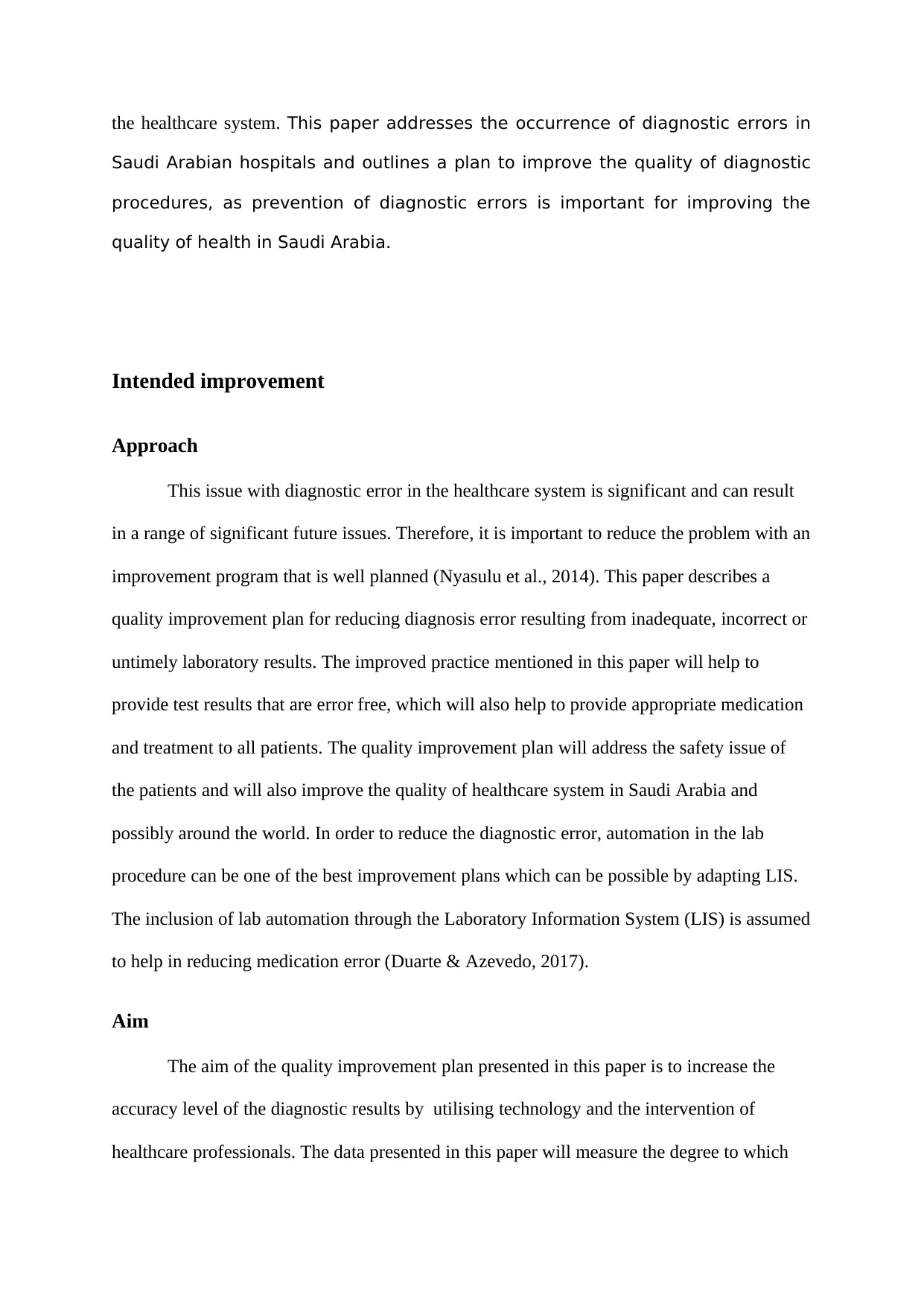
the healthcare system. This paper addresses the occurrence of diagnostic errors in
Saudi Arabian hospitals and outlines a plan to improve the quality of diagnostic
procedures, as prevention of diagnostic errors is important for improving the
quality of health in Saudi Arabia.
Intended improvement
Approach
This issue with diagnostic error in the healthcare system is significant and can result
in a range of significant future issues. Therefore, it is important to reduce the problem with an
improvement program that is well planned (Nyasulu et al., 2014). This paper describes a
quality improvement plan for reducing diagnosis error resulting from inadequate, incorrect or
untimely laboratory results. The improved practice mentioned in this paper will help to
provide test results that are error free, which will also help to provide appropriate medication
and treatment to all patients. The quality improvement plan will address the safety issue of
the patients and will also improve the quality of healthcare system in Saudi Arabia and
possibly around the world. In order to reduce the diagnostic error, automation in the lab
procedure can be one of the best improvement plans which can be possible by adapting LIS.
The inclusion of lab automation through the Laboratory Information System (LIS) is assumed
to help in reducing medication error (Duarte & Azevedo, 2017).
Aim
The aim of the quality improvement plan presented in this paper is to increase the
accuracy level of the diagnostic results by utilising technology and the intervention of
healthcare professionals. The data presented in this paper will measure the degree to which
Saudi Arabian hospitals and outlines a plan to improve the quality of diagnostic
procedures, as prevention of diagnostic errors is important for improving the
quality of health in Saudi Arabia.
Intended improvement
Approach
This issue with diagnostic error in the healthcare system is significant and can result
in a range of significant future issues. Therefore, it is important to reduce the problem with an
improvement program that is well planned (Nyasulu et al., 2014). This paper describes a
quality improvement plan for reducing diagnosis error resulting from inadequate, incorrect or
untimely laboratory results. The improved practice mentioned in this paper will help to
provide test results that are error free, which will also help to provide appropriate medication
and treatment to all patients. The quality improvement plan will address the safety issue of
the patients and will also improve the quality of healthcare system in Saudi Arabia and
possibly around the world. In order to reduce the diagnostic error, automation in the lab
procedure can be one of the best improvement plans which can be possible by adapting LIS.
The inclusion of lab automation through the Laboratory Information System (LIS) is assumed
to help in reducing medication error (Duarte & Azevedo, 2017).
Aim
The aim of the quality improvement plan presented in this paper is to increase the
accuracy level of the diagnostic results by utilising technology and the intervention of
healthcare professionals. The data presented in this paper will measure the degree to which
⊘ This is a preview!⊘
Do you want full access?
Subscribe today to unlock all pages.

Trusted by 1+ million students worldwide
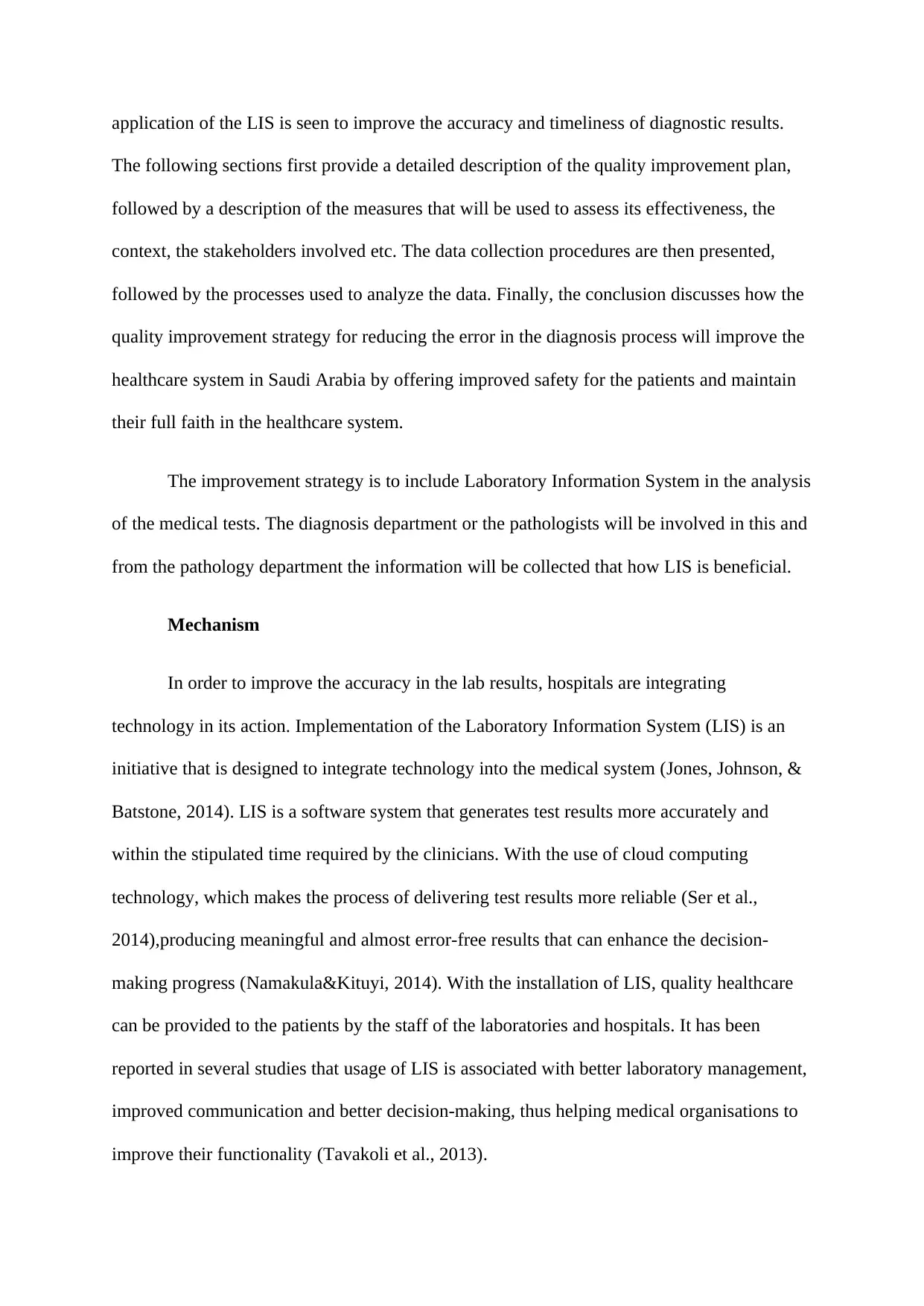
application of the LIS is seen to improve the accuracy and timeliness of diagnostic results.
The following sections first provide a detailed description of the quality improvement plan,
followed by a description of the measures that will be used to assess its effectiveness, the
context, the stakeholders involved etc. The data collection procedures are then presented,
followed by the processes used to analyze the data. Finally, the conclusion discusses how the
quality improvement strategy for reducing the error in the diagnosis process will improve the
healthcare system in Saudi Arabia by offering improved safety for the patients and maintain
their full faith in the healthcare system.
The improvement strategy is to include Laboratory Information System in the analysis
of the medical tests. The diagnosis department or the pathologists will be involved in this and
from the pathology department the information will be collected that how LIS is beneficial.
Mechanism
In order to improve the accuracy in the lab results, hospitals are integrating
technology in its action. Implementation of the Laboratory Information System (LIS) is an
initiative that is designed to integrate technology into the medical system (Jones, Johnson, &
Batstone, 2014). LIS is a software system that generates test results more accurately and
within the stipulated time required by the clinicians. With the use of cloud computing
technology, which makes the process of delivering test results more reliable (Ser et al.,
2014),producing meaningful and almost error-free results that can enhance the decision-
making progress (Namakula&Kituyi, 2014). With the installation of LIS, quality healthcare
can be provided to the patients by the staff of the laboratories and hospitals. It has been
reported in several studies that usage of LIS is associated with better laboratory management,
improved communication and better decision-making, thus helping medical organisations to
improve their functionality (Tavakoli et al., 2013).
The following sections first provide a detailed description of the quality improvement plan,
followed by a description of the measures that will be used to assess its effectiveness, the
context, the stakeholders involved etc. The data collection procedures are then presented,
followed by the processes used to analyze the data. Finally, the conclusion discusses how the
quality improvement strategy for reducing the error in the diagnosis process will improve the
healthcare system in Saudi Arabia by offering improved safety for the patients and maintain
their full faith in the healthcare system.
The improvement strategy is to include Laboratory Information System in the analysis
of the medical tests. The diagnosis department or the pathologists will be involved in this and
from the pathology department the information will be collected that how LIS is beneficial.
Mechanism
In order to improve the accuracy in the lab results, hospitals are integrating
technology in its action. Implementation of the Laboratory Information System (LIS) is an
initiative that is designed to integrate technology into the medical system (Jones, Johnson, &
Batstone, 2014). LIS is a software system that generates test results more accurately and
within the stipulated time required by the clinicians. With the use of cloud computing
technology, which makes the process of delivering test results more reliable (Ser et al.,
2014),producing meaningful and almost error-free results that can enhance the decision-
making progress (Namakula&Kituyi, 2014). With the installation of LIS, quality healthcare
can be provided to the patients by the staff of the laboratories and hospitals. It has been
reported in several studies that usage of LIS is associated with better laboratory management,
improved communication and better decision-making, thus helping medical organisations to
improve their functionality (Tavakoli et al., 2013).
Paraphrase This Document
Need a fresh take? Get an instant paraphrase of this document with our AI Paraphraser
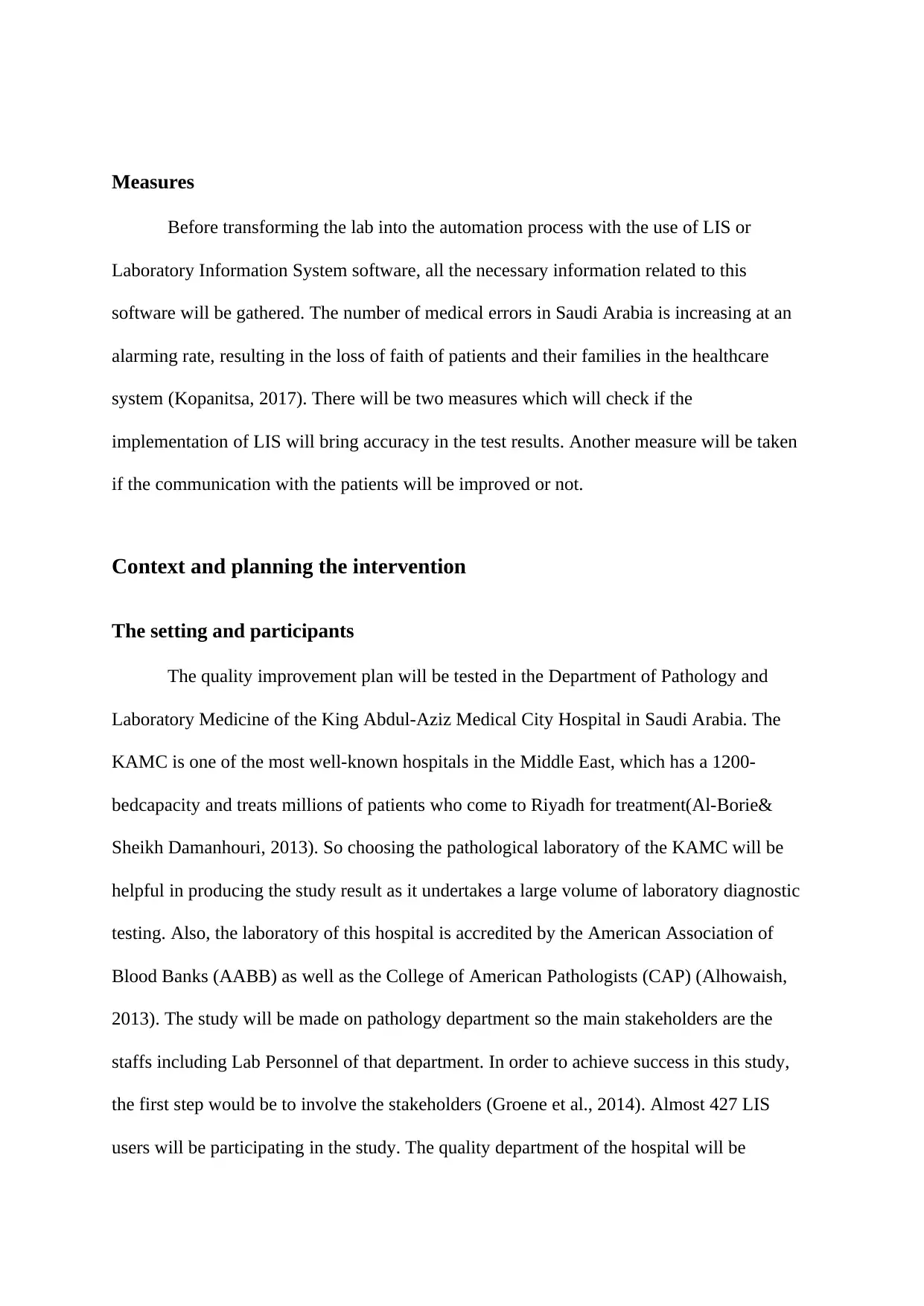
Measures
Before transforming the lab into the automation process with the use of LIS or
Laboratory Information System software, all the necessary information related to this
software will be gathered. The number of medical errors in Saudi Arabia is increasing at an
alarming rate, resulting in the loss of faith of patients and their families in the healthcare
system (Kopanitsa, 2017). There will be two measures which will check if the
implementation of LIS will bring accuracy in the test results. Another measure will be taken
if the communication with the patients will be improved or not.
Context and planning the intervention
The setting and participants
The quality improvement plan will be tested in the Department of Pathology and
Laboratory Medicine of the King Abdul-Aziz Medical City Hospital in Saudi Arabia. The
KAMC is one of the most well-known hospitals in the Middle East, which has a 1200-
bedcapacity and treats millions of patients who come to Riyadh for treatment(Al-Borie&
Sheikh Damanhouri, 2013). So choosing the pathological laboratory of the KAMC will be
helpful in producing the study result as it undertakes a large volume of laboratory diagnostic
testing. Also, the laboratory of this hospital is accredited by the American Association of
Blood Banks (AABB) as well as the College of American Pathologists (CAP) (Alhowaish,
2013). The study will be made on pathology department so the main stakeholders are the
staffs including Lab Personnel of that department. In order to achieve success in this study,
the first step would be to involve the stakeholders (Groene et al., 2014). Almost 427 LIS
users will be participating in the study. The quality department of the hospital will be
Before transforming the lab into the automation process with the use of LIS or
Laboratory Information System software, all the necessary information related to this
software will be gathered. The number of medical errors in Saudi Arabia is increasing at an
alarming rate, resulting in the loss of faith of patients and their families in the healthcare
system (Kopanitsa, 2017). There will be two measures which will check if the
implementation of LIS will bring accuracy in the test results. Another measure will be taken
if the communication with the patients will be improved or not.
Context and planning the intervention
The setting and participants
The quality improvement plan will be tested in the Department of Pathology and
Laboratory Medicine of the King Abdul-Aziz Medical City Hospital in Saudi Arabia. The
KAMC is one of the most well-known hospitals in the Middle East, which has a 1200-
bedcapacity and treats millions of patients who come to Riyadh for treatment(Al-Borie&
Sheikh Damanhouri, 2013). So choosing the pathological laboratory of the KAMC will be
helpful in producing the study result as it undertakes a large volume of laboratory diagnostic
testing. Also, the laboratory of this hospital is accredited by the American Association of
Blood Banks (AABB) as well as the College of American Pathologists (CAP) (Alhowaish,
2013). The study will be made on pathology department so the main stakeholders are the
staffs including Lab Personnel of that department. In order to achieve success in this study,
the first step would be to involve the stakeholders (Groene et al., 2014). Almost 427 LIS
users will be participating in the study. The quality department of the hospital will be

involved in the quality improvement plan by expressing their opinion about the impact of LIS
on producing accurate test results within a stipulated time.
The study will be designed in collaboration with all the staff and doctors. The
stakeholders such as Lab Personnel and other staffs in the pathology department will be
involved in it. The survey will involve a questionnaire in which=staff will elaborate on the
features of LIS, as they are already working with it. Data will be collected from the patients,
laboratory staff and doctors in the questionnaire round of the survey. There will be a set of
questions where the participants will provide their responses, which will be recorded for
further analysis. Study instruments will be given to the patients and doctors and the questions
will cover external communication, service outcome, personal intention, personal hassle, and
user blame. The questions will be distributed in paper-based formats where the participants
will respond with tick marks on whether they highly disagree, disagree, are neutral, agree or
highly agree.
Other stakeholders
The participants are basically the individuals who are directly participating in the
survey by answering the questionnaire and the stakeholders are the individuals who are
involved with the whole study. The experienced workers who have worked with LIS in the
pathology department will also play the role of stakeholders in the implementation of LIS in
the hospitals of Saudi Arabia. The pathology department and the staffs like Lab Personnel
will be another stakeholder in the study.
Limitations of the study
. There are several limitations and barriers that may influence the study. The staff and
other clinicians may not agree to participate in the study (Herzog et al., 2013). The hospital
on producing accurate test results within a stipulated time.
The study will be designed in collaboration with all the staff and doctors. The
stakeholders such as Lab Personnel and other staffs in the pathology department will be
involved in it. The survey will involve a questionnaire in which=staff will elaborate on the
features of LIS, as they are already working with it. Data will be collected from the patients,
laboratory staff and doctors in the questionnaire round of the survey. There will be a set of
questions where the participants will provide their responses, which will be recorded for
further analysis. Study instruments will be given to the patients and doctors and the questions
will cover external communication, service outcome, personal intention, personal hassle, and
user blame. The questions will be distributed in paper-based formats where the participants
will respond with tick marks on whether they highly disagree, disagree, are neutral, agree or
highly agree.
Other stakeholders
The participants are basically the individuals who are directly participating in the
survey by answering the questionnaire and the stakeholders are the individuals who are
involved with the whole study. The experienced workers who have worked with LIS in the
pathology department will also play the role of stakeholders in the implementation of LIS in
the hospitals of Saudi Arabia. The pathology department and the staffs like Lab Personnel
will be another stakeholder in the study.
Limitations of the study
. There are several limitations and barriers that may influence the study. The staff and
other clinicians may not agree to participate in the study (Herzog et al., 2013). The hospital
⊘ This is a preview!⊘
Do you want full access?
Subscribe today to unlock all pages.

Trusted by 1+ million students worldwide
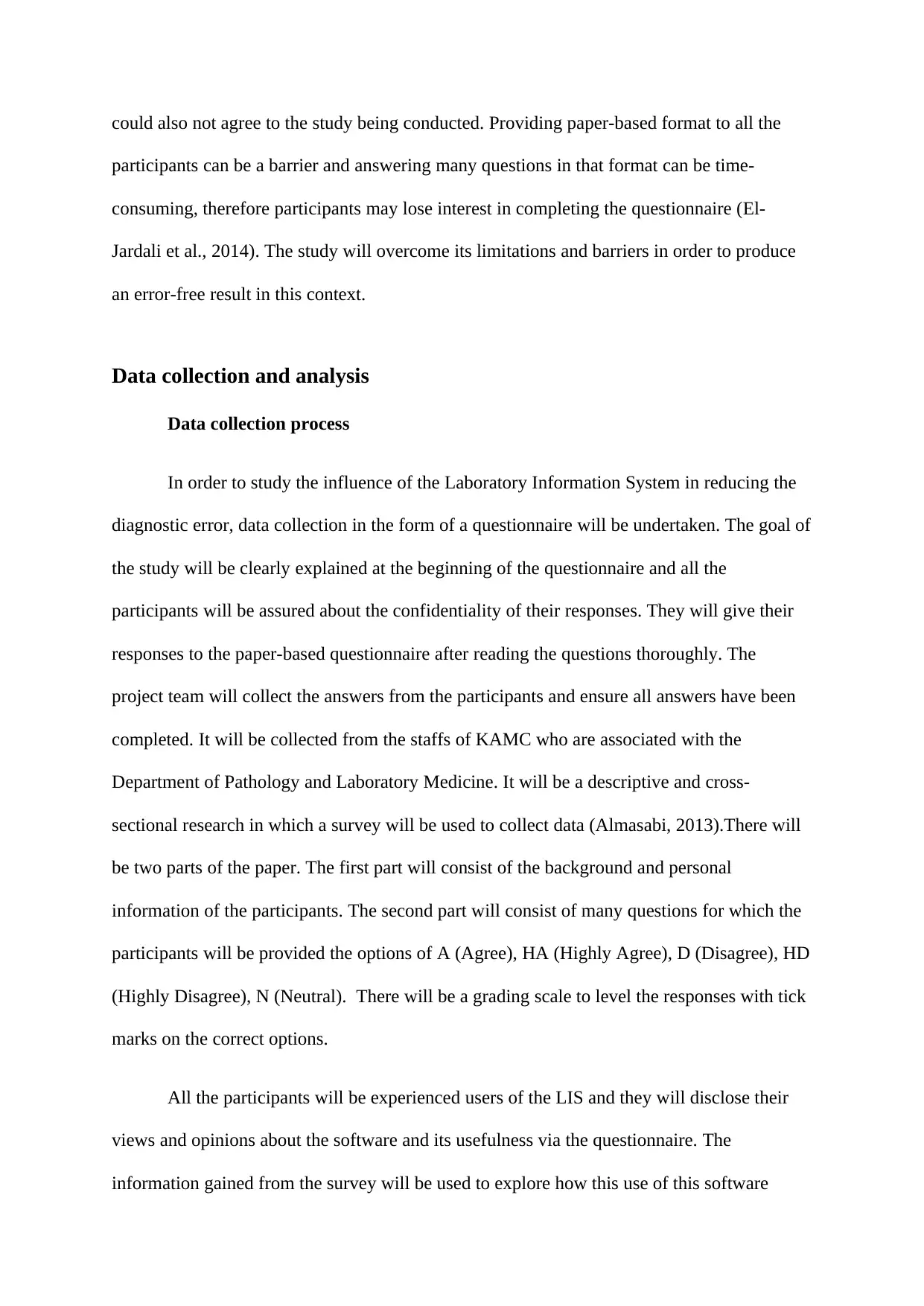
could also not agree to the study being conducted. Providing paper-based format to all the
participants can be a barrier and answering many questions in that format can be time-
consuming, therefore participants may lose interest in completing the questionnaire (El-
Jardali et al., 2014). The study will overcome its limitations and barriers in order to produce
an error-free result in this context.
Data collection and analysis
Data collection process
In order to study the influence of the Laboratory Information System in reducing the
diagnostic error, data collection in the form of a questionnaire will be undertaken. The goal of
the study will be clearly explained at the beginning of the questionnaire and all the
participants will be assured about the confidentiality of their responses. They will give their
responses to the paper-based questionnaire after reading the questions thoroughly. The
project team will collect the answers from the participants and ensure all answers have been
completed. It will be collected from the staffs of KAMC who are associated with the
Department of Pathology and Laboratory Medicine. It will be a descriptive and cross-
sectional research in which a survey will be used to collect data (Almasabi, 2013).There will
be two parts of the paper. The first part will consist of the background and personal
information of the participants. The second part will consist of many questions for which the
participants will be provided the options of A (Agree), HA (Highly Agree), D (Disagree), HD
(Highly Disagree), N (Neutral). There will be a grading scale to level the responses with tick
marks on the correct options.
All the participants will be experienced users of the LIS and they will disclose their
views and opinions about the software and its usefulness via the questionnaire. The
information gained from the survey will be used to explore how this use of this software
participants can be a barrier and answering many questions in that format can be time-
consuming, therefore participants may lose interest in completing the questionnaire (El-
Jardali et al., 2014). The study will overcome its limitations and barriers in order to produce
an error-free result in this context.
Data collection and analysis
Data collection process
In order to study the influence of the Laboratory Information System in reducing the
diagnostic error, data collection in the form of a questionnaire will be undertaken. The goal of
the study will be clearly explained at the beginning of the questionnaire and all the
participants will be assured about the confidentiality of their responses. They will give their
responses to the paper-based questionnaire after reading the questions thoroughly. The
project team will collect the answers from the participants and ensure all answers have been
completed. It will be collected from the staffs of KAMC who are associated with the
Department of Pathology and Laboratory Medicine. It will be a descriptive and cross-
sectional research in which a survey will be used to collect data (Almasabi, 2013).There will
be two parts of the paper. The first part will consist of the background and personal
information of the participants. The second part will consist of many questions for which the
participants will be provided the options of A (Agree), HA (Highly Agree), D (Disagree), HD
(Highly Disagree), N (Neutral). There will be a grading scale to level the responses with tick
marks on the correct options.
All the participants will be experienced users of the LIS and they will disclose their
views and opinions about the software and its usefulness via the questionnaire. The
information gained from the survey will be used to explore how this use of this software
Paraphrase This Document
Need a fresh take? Get an instant paraphrase of this document with our AI Paraphraser
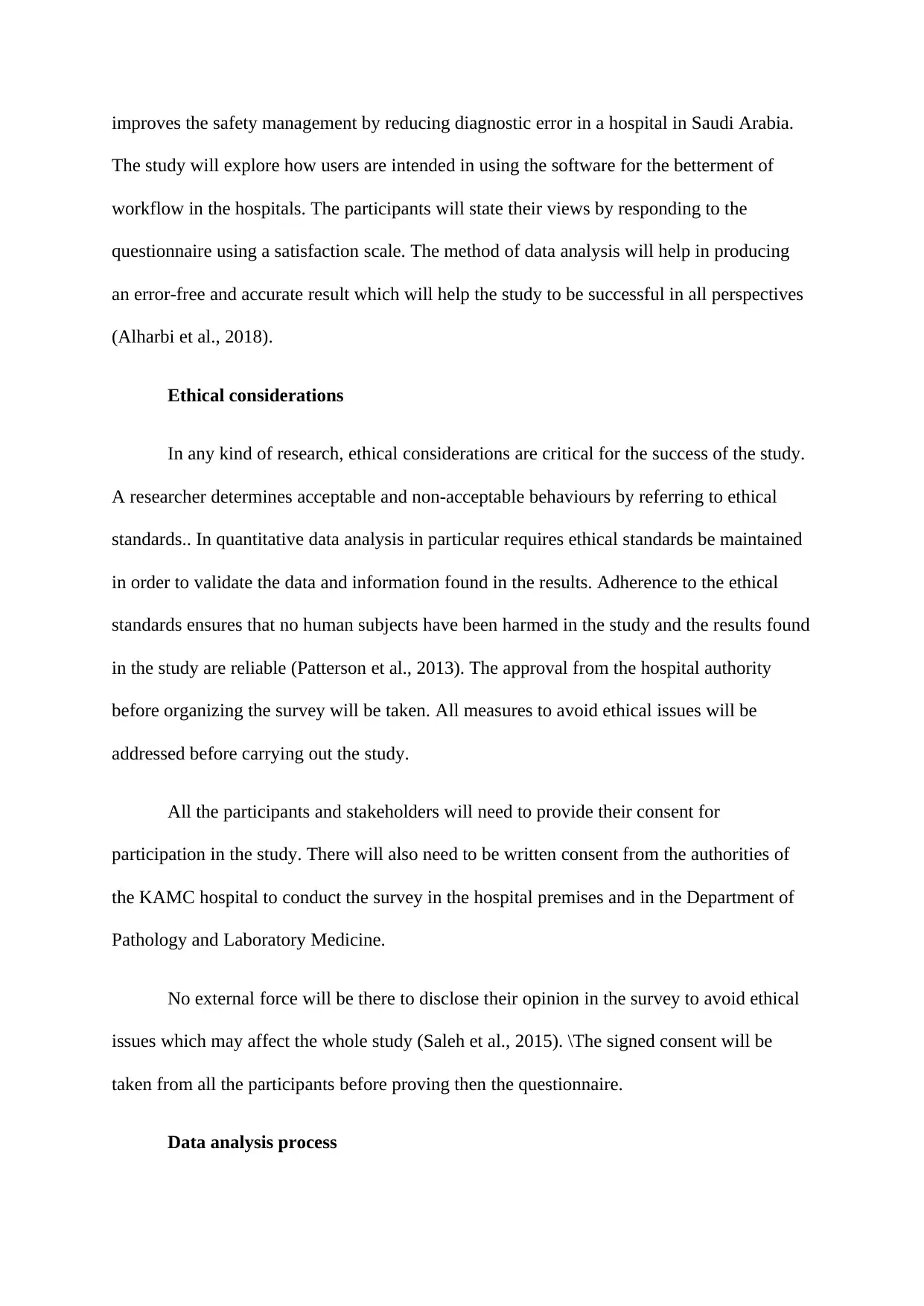
improves the safety management by reducing diagnostic error in a hospital in Saudi Arabia.
The study will explore how users are intended in using the software for the betterment of
workflow in the hospitals. The participants will state their views by responding to the
questionnaire using a satisfaction scale. The method of data analysis will help in producing
an error-free and accurate result which will help the study to be successful in all perspectives
(Alharbi et al., 2018).
Ethical considerations
In any kind of research, ethical considerations are critical for the success of the study.
A researcher determines acceptable and non-acceptable behaviours by referring to ethical
standards.. In quantitative data analysis in particular requires ethical standards be maintained
in order to validate the data and information found in the results. Adherence to the ethical
standards ensures that no human subjects have been harmed in the study and the results found
in the study are reliable (Patterson et al., 2013). The approval from the hospital authority
before organizing the survey will be taken. All measures to avoid ethical issues will be
addressed before carrying out the study.
All the participants and stakeholders will need to provide their consent for
participation in the study. There will also need to be written consent from the authorities of
the KAMC hospital to conduct the survey in the hospital premises and in the Department of
Pathology and Laboratory Medicine.
No external force will be there to disclose their opinion in the survey to avoid ethical
issues which may affect the whole study (Saleh et al., 2015). \The signed consent will be
taken from all the participants before proving then the questionnaire.
Data analysis process
The study will explore how users are intended in using the software for the betterment of
workflow in the hospitals. The participants will state their views by responding to the
questionnaire using a satisfaction scale. The method of data analysis will help in producing
an error-free and accurate result which will help the study to be successful in all perspectives
(Alharbi et al., 2018).
Ethical considerations
In any kind of research, ethical considerations are critical for the success of the study.
A researcher determines acceptable and non-acceptable behaviours by referring to ethical
standards.. In quantitative data analysis in particular requires ethical standards be maintained
in order to validate the data and information found in the results. Adherence to the ethical
standards ensures that no human subjects have been harmed in the study and the results found
in the study are reliable (Patterson et al., 2013). The approval from the hospital authority
before organizing the survey will be taken. All measures to avoid ethical issues will be
addressed before carrying out the study.
All the participants and stakeholders will need to provide their consent for
participation in the study. There will also need to be written consent from the authorities of
the KAMC hospital to conduct the survey in the hospital premises and in the Department of
Pathology and Laboratory Medicine.
No external force will be there to disclose their opinion in the survey to avoid ethical
issues which may affect the whole study (Saleh et al., 2015). \The signed consent will be
taken from all the participants before proving then the questionnaire.
Data analysis process
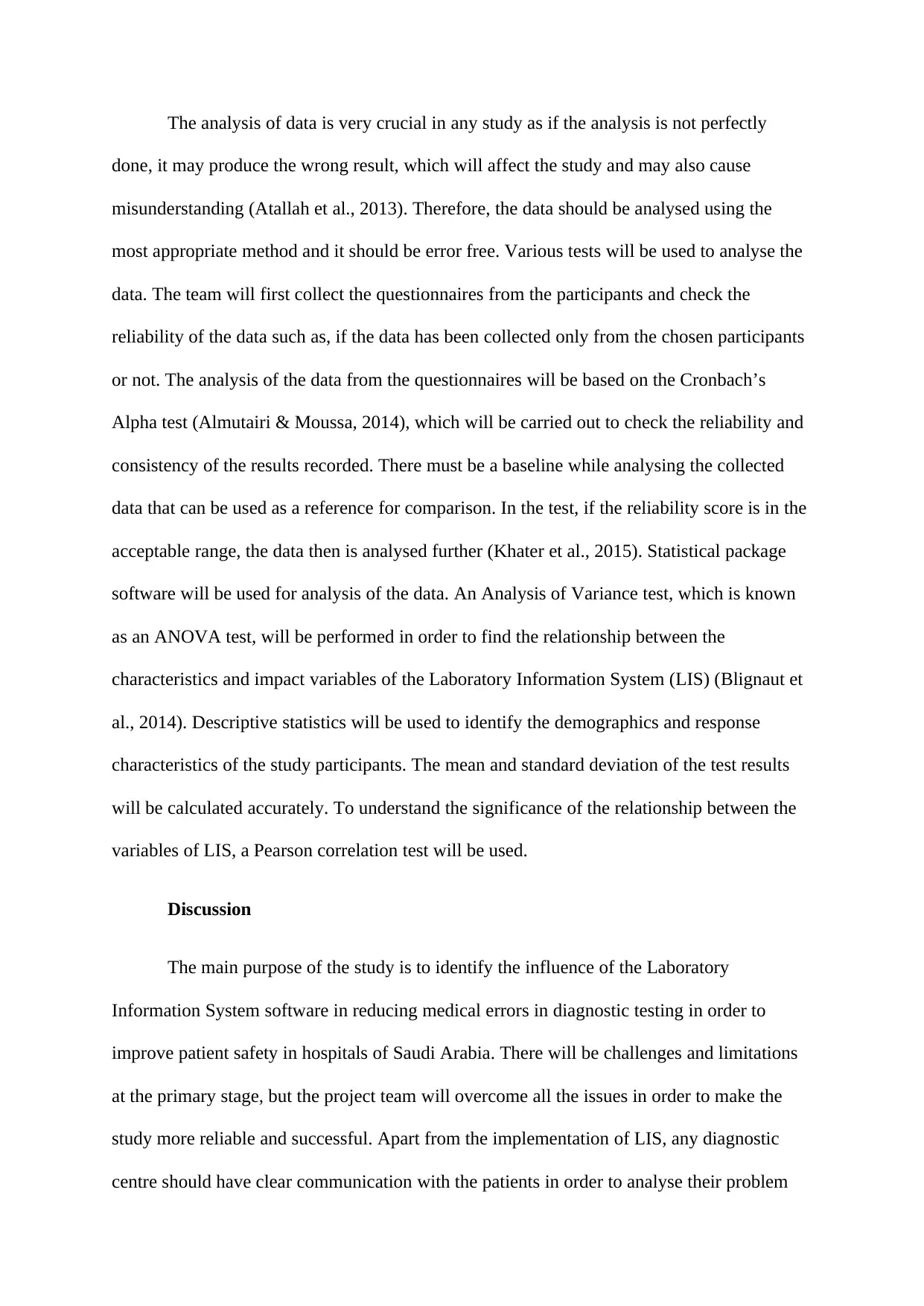
The analysis of data is very crucial in any study as if the analysis is not perfectly
done, it may produce the wrong result, which will affect the study and may also cause
misunderstanding (Atallah et al., 2013). Therefore, the data should be analysed using the
most appropriate method and it should be error free. Various tests will be used to analyse the
data. The team will first collect the questionnaires from the participants and check the
reliability of the data such as, if the data has been collected only from the chosen participants
or not. The analysis of the data from the questionnaires will be based on the Cronbach’s
Alpha test (Almutairi & Moussa, 2014), which will be carried out to check the reliability and
consistency of the results recorded. There must be a baseline while analysing the collected
data that can be used as a reference for comparison. In the test, if the reliability score is in the
acceptable range, the data then is analysed further (Khater et al., 2015). Statistical package
software will be used for analysis of the data. An Analysis of Variance test, which is known
as an ANOVA test, will be performed in order to find the relationship between the
characteristics and impact variables of the Laboratory Information System (LIS) (Blignaut et
al., 2014). Descriptive statistics will be used to identify the demographics and response
characteristics of the study participants. The mean and standard deviation of the test results
will be calculated accurately. To understand the significance of the relationship between the
variables of LIS, a Pearson correlation test will be used.
Discussion
The main purpose of the study is to identify the influence of the Laboratory
Information System software in reducing medical errors in diagnostic testing in order to
improve patient safety in hospitals of Saudi Arabia. There will be challenges and limitations
at the primary stage, but the project team will overcome all the issues in order to make the
study more reliable and successful. Apart from the implementation of LIS, any diagnostic
centre should have clear communication with the patients in order to analyse their problem
done, it may produce the wrong result, which will affect the study and may also cause
misunderstanding (Atallah et al., 2013). Therefore, the data should be analysed using the
most appropriate method and it should be error free. Various tests will be used to analyse the
data. The team will first collect the questionnaires from the participants and check the
reliability of the data such as, if the data has been collected only from the chosen participants
or not. The analysis of the data from the questionnaires will be based on the Cronbach’s
Alpha test (Almutairi & Moussa, 2014), which will be carried out to check the reliability and
consistency of the results recorded. There must be a baseline while analysing the collected
data that can be used as a reference for comparison. In the test, if the reliability score is in the
acceptable range, the data then is analysed further (Khater et al., 2015). Statistical package
software will be used for analysis of the data. An Analysis of Variance test, which is known
as an ANOVA test, will be performed in order to find the relationship between the
characteristics and impact variables of the Laboratory Information System (LIS) (Blignaut et
al., 2014). Descriptive statistics will be used to identify the demographics and response
characteristics of the study participants. The mean and standard deviation of the test results
will be calculated accurately. To understand the significance of the relationship between the
variables of LIS, a Pearson correlation test will be used.
Discussion
The main purpose of the study is to identify the influence of the Laboratory
Information System software in reducing medical errors in diagnostic testing in order to
improve patient safety in hospitals of Saudi Arabia. There will be challenges and limitations
at the primary stage, but the project team will overcome all the issues in order to make the
study more reliable and successful. Apart from the implementation of LIS, any diagnostic
centre should have clear communication with the patients in order to analyse their problem
⊘ This is a preview!⊘
Do you want full access?
Subscribe today to unlock all pages.

Trusted by 1+ million students worldwide
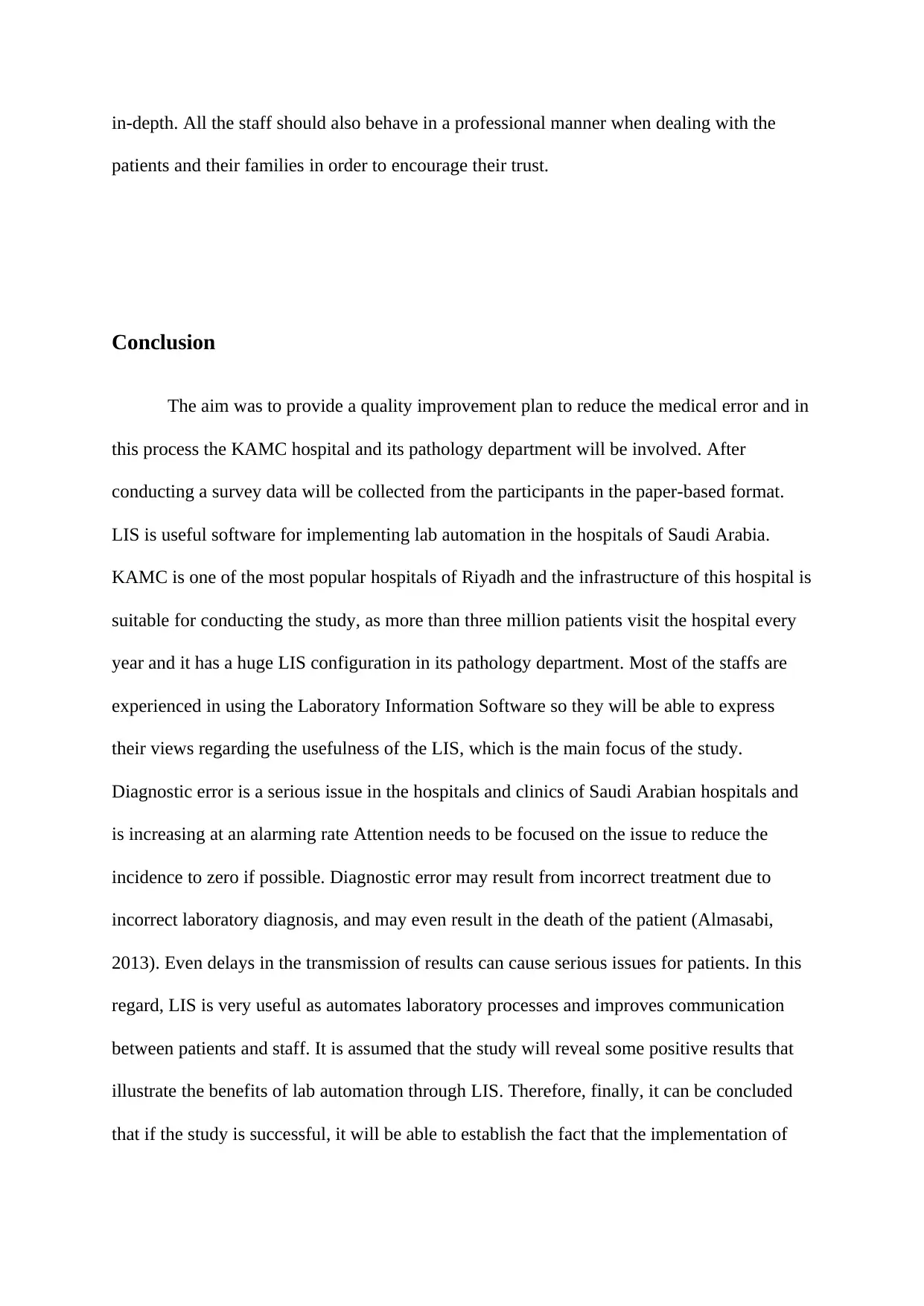
in-depth. All the staff should also behave in a professional manner when dealing with the
patients and their families in order to encourage their trust.
Conclusion
The aim was to provide a quality improvement plan to reduce the medical error and in
this process the KAMC hospital and its pathology department will be involved. After
conducting a survey data will be collected from the participants in the paper-based format.
LIS is useful software for implementing lab automation in the hospitals of Saudi Arabia.
KAMC is one of the most popular hospitals of Riyadh and the infrastructure of this hospital is
suitable for conducting the study, as more than three million patients visit the hospital every
year and it has a huge LIS configuration in its pathology department. Most of the staffs are
experienced in using the Laboratory Information Software so they will be able to express
their views regarding the usefulness of the LIS, which is the main focus of the study.
Diagnostic error is a serious issue in the hospitals and clinics of Saudi Arabian hospitals and
is increasing at an alarming rate Attention needs to be focused on the issue to reduce the
incidence to zero if possible. Diagnostic error may result from incorrect treatment due to
incorrect laboratory diagnosis, and may even result in the death of the patient (Almasabi,
2013). Even delays in the transmission of results can cause serious issues for patients. In this
regard, LIS is very useful as automates laboratory processes and improves communication
between patients and staff. It is assumed that the study will reveal some positive results that
illustrate the benefits of lab automation through LIS. Therefore, finally, it can be concluded
that if the study is successful, it will be able to establish the fact that the implementation of
patients and their families in order to encourage their trust.
Conclusion
The aim was to provide a quality improvement plan to reduce the medical error and in
this process the KAMC hospital and its pathology department will be involved. After
conducting a survey data will be collected from the participants in the paper-based format.
LIS is useful software for implementing lab automation in the hospitals of Saudi Arabia.
KAMC is one of the most popular hospitals of Riyadh and the infrastructure of this hospital is
suitable for conducting the study, as more than three million patients visit the hospital every
year and it has a huge LIS configuration in its pathology department. Most of the staffs are
experienced in using the Laboratory Information Software so they will be able to express
their views regarding the usefulness of the LIS, which is the main focus of the study.
Diagnostic error is a serious issue in the hospitals and clinics of Saudi Arabian hospitals and
is increasing at an alarming rate Attention needs to be focused on the issue to reduce the
incidence to zero if possible. Diagnostic error may result from incorrect treatment due to
incorrect laboratory diagnosis, and may even result in the death of the patient (Almasabi,
2013). Even delays in the transmission of results can cause serious issues for patients. In this
regard, LIS is very useful as automates laboratory processes and improves communication
between patients and staff. It is assumed that the study will reveal some positive results that
illustrate the benefits of lab automation through LIS. Therefore, finally, it can be concluded
that if the study is successful, it will be able to establish the fact that the implementation of
Paraphrase This Document
Need a fresh take? Get an instant paraphrase of this document with our AI Paraphraser

LIS in the labs will help to produce an error-free result to assist practitioners in appropriate
diagnoses of patients’ health issues.
diagnoses of patients’ health issues.
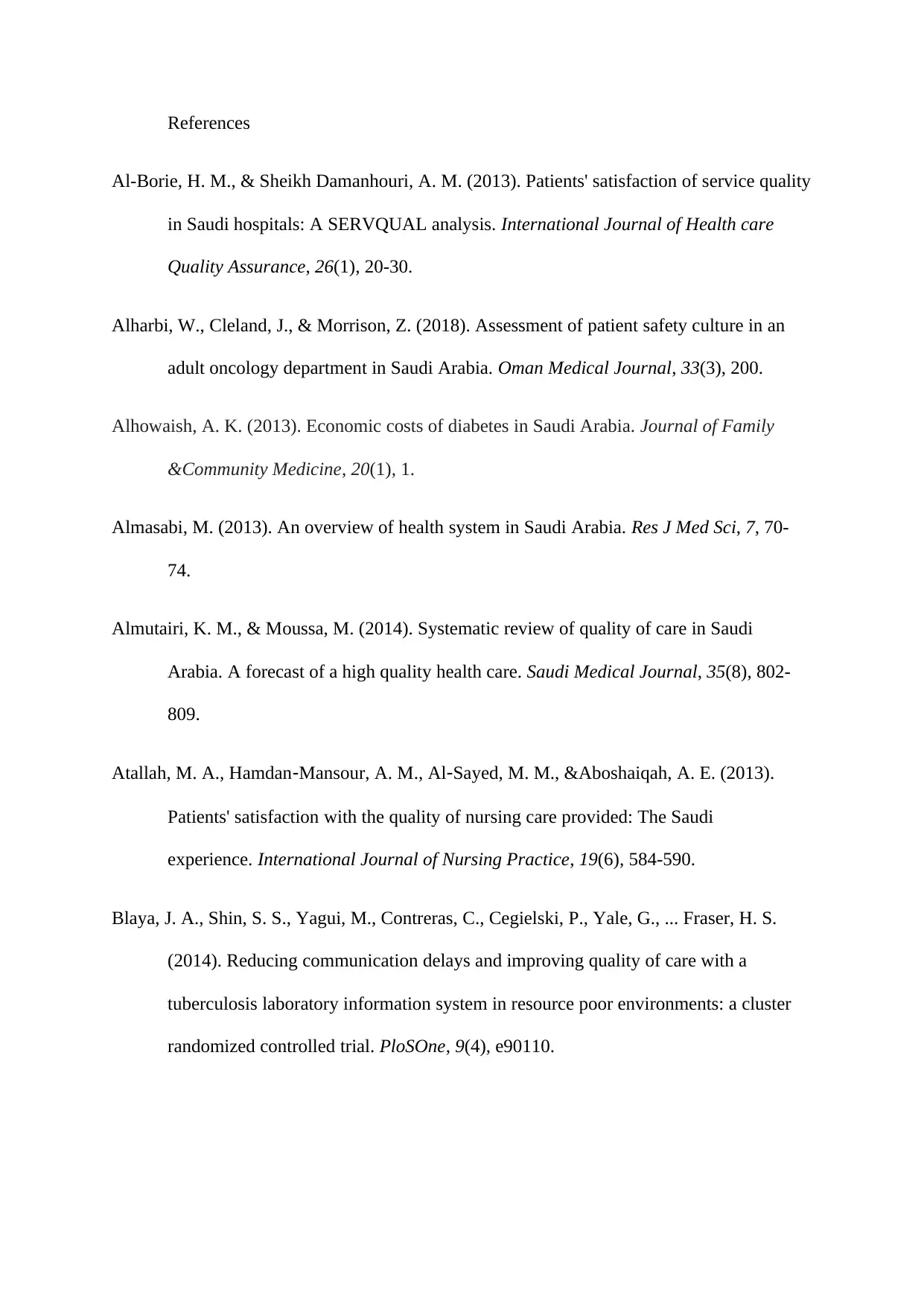
References
Al-Borie, H. M., & Sheikh Damanhouri, A. M. (2013). Patients' satisfaction of service quality
in Saudi hospitals: A SERVQUAL analysis. International Journal of Health care
Quality Assurance, 26(1), 20-30.
Alharbi, W., Cleland, J., & Morrison, Z. (2018). Assessment of patient safety culture in an
adult oncology department in Saudi Arabia. Oman Medical Journal, 33(3), 200.
Alhowaish, A. K. (2013). Economic costs of diabetes in Saudi Arabia. Journal of Family
&Community Medicine, 20(1), 1.
Almasabi, M. (2013). An overview of health system in Saudi Arabia. Res J Med Sci, 7, 70-
74.
Almutairi, K. M., & Moussa, M. (2014). Systematic review of quality of care in Saudi
Arabia. A forecast of a high quality health care. Saudi Medical Journal, 35(8), 802-
809.
Atallah, M. A., Hamdan‐Mansour, A. M., Al‐Sayed, M. M., &Aboshaiqah, A. E. (2013).
Patients' satisfaction with the quality of nursing care provided: The Saudi
experience. International Journal of Nursing Practice, 19(6), 584-590.
Blaya, J. A., Shin, S. S., Yagui, M., Contreras, C., Cegielski, P., Yale, G., ... Fraser, H. S.
(2014). Reducing communication delays and improving quality of care with a
tuberculosis laboratory information system in resource poor environments: a cluster
randomized controlled trial. PloSOne, 9(4), e90110.
Al-Borie, H. M., & Sheikh Damanhouri, A. M. (2013). Patients' satisfaction of service quality
in Saudi hospitals: A SERVQUAL analysis. International Journal of Health care
Quality Assurance, 26(1), 20-30.
Alharbi, W., Cleland, J., & Morrison, Z. (2018). Assessment of patient safety culture in an
adult oncology department in Saudi Arabia. Oman Medical Journal, 33(3), 200.
Alhowaish, A. K. (2013). Economic costs of diabetes in Saudi Arabia. Journal of Family
&Community Medicine, 20(1), 1.
Almasabi, M. (2013). An overview of health system in Saudi Arabia. Res J Med Sci, 7, 70-
74.
Almutairi, K. M., & Moussa, M. (2014). Systematic review of quality of care in Saudi
Arabia. A forecast of a high quality health care. Saudi Medical Journal, 35(8), 802-
809.
Atallah, M. A., Hamdan‐Mansour, A. M., Al‐Sayed, M. M., &Aboshaiqah, A. E. (2013).
Patients' satisfaction with the quality of nursing care provided: The Saudi
experience. International Journal of Nursing Practice, 19(6), 584-590.
Blaya, J. A., Shin, S. S., Yagui, M., Contreras, C., Cegielski, P., Yale, G., ... Fraser, H. S.
(2014). Reducing communication delays and improving quality of care with a
tuberculosis laboratory information system in resource poor environments: a cluster
randomized controlled trial. PloSOne, 9(4), e90110.
⊘ This is a preview!⊘
Do you want full access?
Subscribe today to unlock all pages.

Trusted by 1+ million students worldwide
1 out of 15
Related Documents
Your All-in-One AI-Powered Toolkit for Academic Success.
+13062052269
info@desklib.com
Available 24*7 on WhatsApp / Email
![[object Object]](/_next/static/media/star-bottom.7253800d.svg)
Unlock your academic potential
Copyright © 2020–2025 A2Z Services. All Rights Reserved. Developed and managed by ZUCOL.





